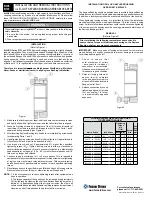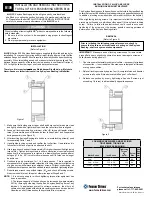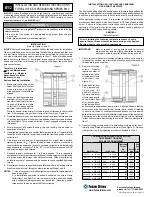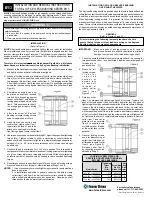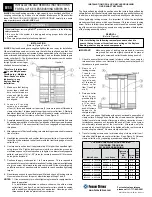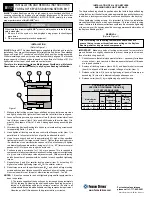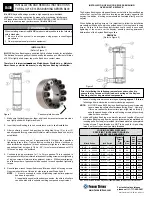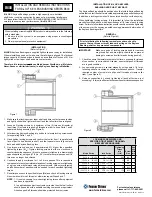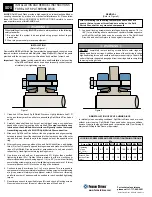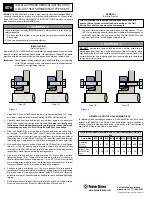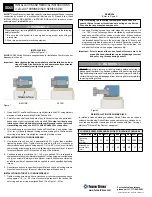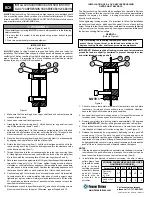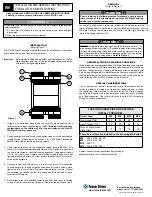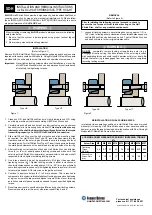
www.fennerdrives.com
For technical assistance,
please call +1-717-665-2421
INSTALLATION
(Refer to Figure 1)
B-LOC®
Keyless Bushings are supplied lightly oiled and ready for installation.
When reinstalling a used unit, make sure that all slits are aligned. The frictional
torque capacity of these devices is based on a coefficient of friction of 0.12 for
lightly oiled screw, taper, shaft and bore contact areas.
Therefore, it is important not to use Molybdenum Disulfide (e.g., Molykote,
Never-Seeze or similar lubricants) in any Keyless Bushing installation.
INSTALLATION OF B-LOC® KEYLESS
BUSHING OVER SHAFT KEYWAYS
The Keyless Bushing should be positioned so that slits in Keyless Bushing
collars that contact the shaft are located approximately opposite the keyway.
In addition, a locking screw should be centered directly over the keyway.
When tightening locking screws, it is important to follow the installation
procedure outlined above, which specifies equal 1/4 turns of each locking
screw. Failure to follow these instructions could result in excessive tightening
of the screw over the keyway, possibly causing permanent deformation of
the Keyless Bushing collars.
REMOVAL
(Refer to Figure 2)
Prior to initiating the following removal procedure, check to
ensure that no torque or thrust loads are acting on the Keyless
Bushing, shaft or any mounted components.
IMPORTANT!
Make sure ends of locking screws used for removal
are ground flat and are slightly chamfered to prevent
damage to screw and collar threads during push-off.
1. Check to ensure that axial movement of collars - necessary for release
of connection - is not restricted. Likewise, ensure that push-off threads
are in good condition.
2. Loosen locking screws in several stages by using approx. 1/4 turns,
following either a clockwise or counterclockwise sequence. Transfer
required number of screws into all push-off threads of clamp collar
Item 1 (see Figure 2).
3. Release connection by evenly tightening all push-off screws (not
exceeding 1/4 turns) in either a clockwise or counterclockwise sequence.
1. Make sure that locking screw, taper, shaft and bore contact areas are clean
and lightly oiled with a light machine oil and that all collar slits are aligned.
2. Loosen all locking screws by a minimum of two (2) turns and transfer at
least three (3) screws into push-off threads in order to keep Parts 1 and 2
separated during assembly (see Figure 2).
3. After inserting Keyless Bushing into hub bore, relocate locking screws used
for separating Parts 1 and 2.
4. Hand tighten locking screws and confirm that collar Item 1 is parallel with
face of part to be attached to shaft, and that spacer sleeve fully contacts
both part and Keyless Bushing face.
5. Use torque wrench and set it approximately 5% higher than specified
tightening torque (Ma). Tighten locking screws in either a clockwise or
counterclockwise sequence (it is not necessary to tighten in a diametrically
opposite pattern), using only 1/4 (i.e., 90°) turns for several passes until 1/4
turns can no longer be achieved.
6. Continue to apply overtorque for 1 to 2 more passes. This is required to
compensate for a system-related relaxation of locking screws since tightening
of a given screw will always relax adjacent screws. Without overtorquing,
an infinite number of passes would be needed to reach specified tightening
torque.
7. Reset torque wrench to specified torque (Ma) and check all locking screws.
No screw should turn at this point, otherwise repeat Steps 6 and 7.
NOTE
: 1. It is not necessary to re-check tightening torque after equipment
has been in operation.
2. In applications subject to extreme corrosion, the slits in all collars
should be sealed with a suitable caulking compound or equivalent.
Likewise, push-off threads should be protected from corrosion.
©2012 Fenner Drives B-PR-017 9/17/2012
INSTALLATION AND REMOVAL INSTRUCTIONS
FOR B-LOC
®
KEYLESS BUSHING SERIES B800
B800
Figure 2
B-LOC
® Keyless Bushings provide a high capacity, zero-backlash
shaft/hub or coupling connection by means of a mechanical interference
fit. Please follow these INSTALLATION AND REMOVAL INSTRUCTIONS
carefully to ensure proper performance of this
B-LOC
® unit.
WARNING
When installing or removing
B-LOC
®
products, always adhere to the following
safety standards:
1. Be sure that the system is de-energized using proper lockout/tagout
procedures.
2. Wear proper personal protective equipment.
Figure 1
LOCKING SCREW SIZES AND
SPECIFIED TIGHTENING TORQUE M
a
B800 KEYLESS BUSHING
Metric Series
Inch Series
Tightening
Torque
Ma
(ft lb)
Screw
Size
Hex
Key
Size
(mm)
6 x 14 to
14 x 23
1/4 to 1/2
3.55
M4
3
15 x 24 to
42 x 55
5/8 to 1-5/8
12
M6
5
45 x 59 to
65 x 84
1-11/16 to 2-1/2
30
M8
6
70 x 90 to
95 x 120
2-5/8 to 3-3/4
60
M10
8
100 x 125 to 130 x 165
3-7/8 to 4-15/16
105
M12
10


